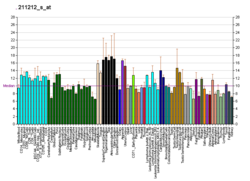
DNA replication licensing factor MCM6 is a protein that in humans is encoded by the MCM6 gene. MCM6 is one of the highly conserved mini-chromosome maintenance proteins (MCM) that are essential for the initiation of eukaryotic genome replication.
In molecular biology, origin recognition complex (ORC) is a multi-subunit DNA binding complex that binds in all eukaryotes and archaea in an ATP-dependent manner to origins of replication. The subunits of this complex are encoded by the ORC1, ORC2, ORC3, ORC4, ORC5 and ORC6 genes. ORC is a central component for eukaryotic DNA replication, and remains bound to chromatin at replication origins throughout the cell cycle.

Eukaryotic DNA replication is a conserved mechanism that restricts DNA replication to once per cell cycle. Eukaryotic DNA replication of chromosomal DNA is central for the duplication of a cell and is necessary for the maintenance of the eukaryotic genome.

The minichromosome maintenance protein complex (MCM) is a DNA helicase essential for genomic DNA replication. Eukaryotic MCM consists of six gene products, Mcm2–7, which form a heterohexamer. As a critical protein for cell division, MCM is also the target of various checkpoint pathways, such as the S-phase entry and S-phase arrest checkpoints. Both the loading and activation of MCM helicase are strictly regulated and are coupled to cell growth cycles. Deregulation of MCM function has been linked to genomic instability and a variety of carcinomas.

Replication protein A 70 kDa DNA-binding subunit is a protein that in humans is encoded by the RPA1 gene.

DNA replication licensing factor MCM7 is a protein that in humans is encoded by the MCM7 gene.

DNA replication licensing factor MCM2 is a protein that in humans is encoded by the MCM2 gene.

DNA replication licensing factor MCM3 is a protein that in humans is encoded by the MCM3 gene.

Cell division control protein 6 homolog is a protein that in humans is encoded by the CDC6 gene.

DNA replication licensing factor MCM4 is a protein that in humans is encoded by the MCM4 gene.

Origin recognition complex subunit 2 is a protein that is encoded by the ORC2 (ORC2L) gene in humans.

Cell division cycle 7-related protein kinase is an enzyme that in humans is encoded by the CDC7 gene. The Cdc7 kinase is involved in regulation of the cell cycle at the point of chromosomal DNA replication. The gene CDC7 appears to be conserved throughout eukaryotic evolution; this means that most eukaryotic cells have the Cdc7 kinase protein.

Protein DBF4 homolog A is a protein that is encoded by the DBF4 gene in humans.

Origin recognition complex subunit 4 is a protein that in humans is encoded by the ORC4 (ORC4L) gene.

Origin recognition complex subunit 6 is a protein that in humans is encoded by the ORC6 (ORC6L) gene.

Protein MCM10 homolog is a protein that in humans is encoded by the MCM10 gene. It is essential for activation of the Cdc45:Mcm2-7:GINS helicase, and thus required for proper DNA replication.

CDC45 is a protein that in humans is encoded by the CDC45L gene.

Origin recognition complex subunit 3 is a protein that in humans is encoded by the ORC3 (ORC3L) gene.

Cdc6, or cell division cycle 6, is a protein in eukaryotic cells. It is mainly studied in the budding yeast Saccharomyces cerevisiae. It is an essential regulator of DNA replication and plays important roles in the activation and maintenance of the checkpoint mechanisms in the cell cycle that coordinate S phase and mitosis. It is part of the pre-replicative complex (pre-RC) and is required for loading minichromosome maintenance (MCM) proteins onto the DNA, an essential step in the initiation of DNA synthesis. In addition, it is a member of the family of AAA+ ATPases and highly related to ORC1; both are the same protein in archaea.

Origin recognition complex subunit 1 is a protein that in humans is encoded by the ORC1 gene. It is closely related to CDC6, and both are the same protein in archaea.



















